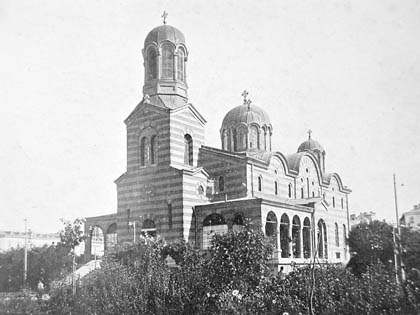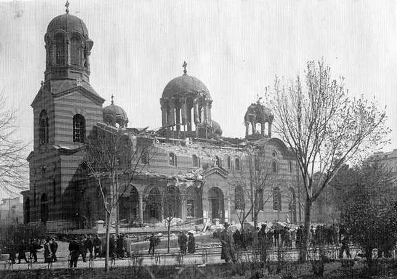

Church of Saint Nedelya or Holy Sunday is located in the center
of the Bulgarian capital of Sofia. It was constructed on the
site of the ancient Roman ruins. The history of the earliest
years of the cathedral is little known. It is likely that the
original structure was built in the X century and had a stone
foundation and wooden walls. The church is mentioned in travel
notes of the German traveler Stefan Gerlach , who visited Sofia
in 1578 .
Around 1460, the relics of the Serbian king
Stephen II Milutin were transferred to Bulgaria. They were
preserved in various churches and monasteries. Finally, they
were placed in the Cathedral of Holy Week after this church
became cathedral in the 18th century . After that, the church
received a new name - the Church of the Holy King ( Bulgarian.
Sveti Kral ). So she was called in the late XIX - early XX
centuries. The building remained wooden until the middle of the
XIX century - unlike most other Sofia churches.
After the
fire, the former building was dismantled on April 25, 1856, in
order to build a more impressive cathedral in its place. The
construction of a new building, 35.5 meters long and 19 meters
wide, began in the summer of the same year. An unfinished
building was damaged by the earthquake of 1858 , which extended
the construction period, which eventually ended in 1863
(architect Ivan Boyanin). The consecration of the new cathedral
took place on May 11, 1867 in the presence of 20,000 people. The
new bell tower was built with the placement of 8 bells, donated
to the church by Prince Dondukov-Korsakov in 1879 .
In 1925 Communist party of Bulgaria carried out a terrorist act against the Royal family. Fortunately the family left the church when this happened. Unfortunately 200 people were killed by the bomb that was planted underneath the dome of the church. The roof and new domes were replaced in neo- Byzantine style that was designed by architects Tsolov and Vasiliev.


Before and after the explosion of 1925
History and architecture
Holy Sunday Church is
the cathedral of the Metropolitan of Sofia. It occupies the site of
the old Kurucheshme Square, which is famous for its spring,
overshadowed by centuries-old trees. Today, the square is called
Holy Sunday.
In the nineteenth and first decades of the
twentieth century, the temple was also called "Saint King" because
it housed the relics of Serbian King Stefan Uros II (1282 - 1321).
Around 1460, during a plague epidemic, Metropolitan Silvani of Sofia
transferred them from the village of Trepche, north of Pristina, to
the present-day Lyulin Monastery "St. Cyril and Methodius "(also
called" St. King "). They were subsequently transferred sequentially
to the "St. St. George, in the church "St. Disembodied Forces "(or"
St. Archangels "), at the Metropolitan Church of St. Marina. "
Probably at the beginning of the eighteenth century the temple "St.
Sunday "became metropolitan and the relics of the Serbian king were
transferred to it.
Probably the original church was built in
the 10th century and like other temples of Sofia at that time it had
stone foundations, and upwards with a wooden structure. In this
form, the temple existed until the mid-19th century.
In the
early 1950s, the Metropolitan of Sofia and the Sofia City Church
decided to build a new cathedral. On May 7, 1856, the construction
of the new church began. It is a three-nave basilica with a length
of 35.5 meters and a width of 19 meters.
In the autumn of
1863 the construction of the new church was completed (architect
Ivan Boyanin). Its decoration lasts for several more years and this
slows it down. From 1863 to 1865 the carver Anton Stanishev made the
iconostasis. Part of the iconic icons is painted by the great
painter Stanislav Dospevski. The consecration of the temple takes
place in 1867 on the feast of 11 May.
During the interim
Russian rule (1877 - 1879) Prince Alexander Dondukov-Korsakov
donated to the temple a set of 8 bells of different sizes. The small
bell towers proved unfit for them, and in 1879 a new bell tower was
built in the southern part of the temple courtyard.
At the
end of the 19th century, in the face of large-scale urban changes in
the center of the capital, the church board decided to strengthen
the surrounding terrain and give a more representative appearance to
the temple. The design was commissioned in 1898 by architect Nikola
Lazarov. For three years, a grand redevelopment has been completed.
A magnificent bell tower is being built on the west side of the
temple. The three domes and the roof were gradually taken down,
replacing five new domes - one large central, flanked by four
smaller ones. All temple walls are lined with brickwork. The terrace
on which the church appears after regulation of the level of the
surrounding streets is also strengthened. Wide stairs to the north,
west and south have been built.
Exarch Joseph I died on June
20, 1915. He was buried on the south side of the temple, near the
side altar door. Three years later, Metropolitan Partenius of Sofia,
who is buried on the north side of the temple, rests.
The
church became famous during the attack on April 16, 1925, during the
funeral of General Konstantin Georgiev, when it was destroyed. 193
people were killed and about 500 were injured. It is believed to be
the most serious terrorist act in the history of Bulgaria, and at
that time in the world.
After this bloody terrorist act of
the Bulgarian Communist Party, the church board assigned the
architectural bureau “Vasilyov-Tsolov” (architect Ivan Vasilyov and
architect Dimitar Tsolov) to rebuild the temple. Renovation began in
June 1927. By the spring of 1933, a nearly new, huge central dome
temple was built, with a length of 30 meters, a width of 15.50
meters, and a height with a dome of 31 meters. The surviving two-row
gilded iconostasis was returned to the temple. The altar portion of
the new temple was significantly expanded, leaving three thrones
again: central - in honor of the Holy Martyr Sunday; north - in
honor of St. Michael the Archangel and south - in honor of the Holy
Martyr and Archdeacon Stephen. In front of this southern throne is a
chest with the relics of St. Stephen Milutin. Near it is a carved
bishop's throne made by Ivan Travnicki. In the western part of the
temple are the narthex, baptistery, office of the temple and
candlestick. Under the dome of the belfry are hung 11 bells - 8
donated by Prince Dondukov-Korsakov in 1879, two made in Serbia and
one cast in Bulgaria.
The temple was solemnly consecrated on April 7,
1933. The mural decoration was made from 1971 to 1973 by an artistic
team led by Nikolay Rostovtsev.
In 1992-1994, the temple
floor was renovated and the northern colonnade was glazed. And in
2000 the exterior facade of the temple was completely cleaned. In
2002, a bell beater was installed in the belfry.